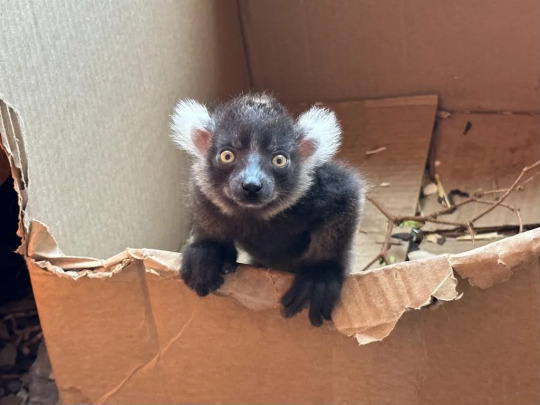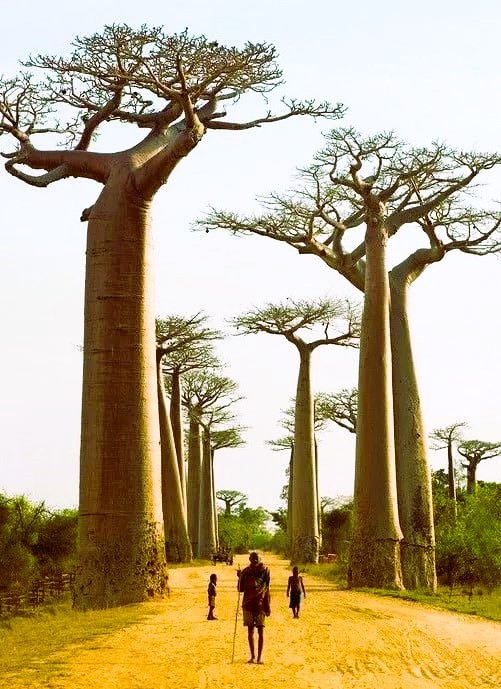#menabe
Explore tagged Tumblr posts
Text
The Avenue of Baobab - Menabe region of western Madagascar
#The Avenue of Baobab#The#Avenue#of#Baobab#Madagascar#The Avenue of Baobab - Menabe region of western Madagascar#Menabe#region#western#Island#Africa
8 notes
·
View notes
Text
The Best News of Last Week - May 15, 2023
🐕 - Now It's a Paw-ty
1. World's oldest ever dog celebrates 31st birthday

Bobi was born on 11 May 1992, making him 31 years old, in human years. A big birthday party is planned for Bobi today, according to Guinness World Records.
It will take place at his home in the rural Portuguese village of Conqueiros in Leiria, western Portugal, where he has lived his entire life.
2. The FDA has officially changed its policy to allow more gay and bisexual men to donate blood

The Food and Drug Administration (FDA) has announced that they’ve eased restrictions on blood donations by men who have sex with men in an effort to address blood shortages. The new policy recommends a series of individual risk-based questions that will apply to all donors, regardless of their sexual orientation, sex, or gender. Gay or bisexual men in monogamous relationships will now be permitted to donate blood.
3. Illinois passes bill to ensure community college credits transfer to public universities

The Illinois General Assembly has passed a bill that would help community college students transfer to public universities.
It would ensure that certain classes taken at community colleges could be transferred to any higher education institution in the state. Some schools currently only count community college coursework as elective credits.
4. Brazilian President Lula recognizes 6 new indigenous territories stretching 620,000 hectares, banning mining and restricting farming within them

Brazilian President Luiz Inácio Lula da Silva has decreed six new indigenous reserves, banning mining and restricting commercial farming there. The lands - including a vast area of Amazon rainforest - cover about 620,000 hectares (1.5m acres).
Indigenous leaders welcomed the move, but said more areas needed protection.
5. More than 1,000 trafficking victims rescued in separate operations in Southeast Asia
More than 1,000 trafficking victims were rescued in separate operations in Southeast Asia over the last week, officials in Indonesia and the Philippines said.
Indonesian officials said Sunday they freed 20 of their nationals who were trafficked to Myanmar as part of a cyber scam, amid an increase in human trafficking cases in Southeast Asia. Fake recruiters had offered the Indonesians high-paying jobs in Thailand but instead trafficked them to Myawaddy, about 567 kilometers (352 miles) south of Naypyidaw, the capital, to perform cyber scams for crypto websites or apps, said Judha Nugraha, an official in Indonesia's Foreign Affairs Ministry.
6. A peanut allergy patch is making headway in trials

An experimental “peanut patch” is showing some promise for toddlers who are highly allergic to peanuts. The patch, called Viaskin, was tested on children ages one to three for a late-stage trial, and the results show that the patch helped children whose bodies could not tolerate even a small piece of peanuts safely eat a few.
After one year, two-thirds of the children who used the patch and one-third of the placebo group met the trial’s primary endpoint. The participants with a less sensitive peanut allergy could safely tolerate the peanut protein equivalent of eating three or four peanuts.
7. Critically endangered lemur born at Calgary Zoo

The Calgary Zoo has released pictures of its newest addition, a baby lemur. The zoo says its four-year-old female black-and-white ruffed lemur, Eny, gave birth on April 7. The pup’s father is eight-year-old Menabe. The gender of the pup has not been confirmed but the Calgary Zoo says the pup appears bright-eyed and active and is on the move.
The black-and-white ruffed lemur is registered among the 25 most endangered primates in the world, due mostly to habitat loss and hunting.
----
That's it for this week :)
This newsletter will always be free. If you liked this post you can support me with a small kofi donation:
Buy me a coffee ❤️
Also don’t forget to reblog.
SUBCRIBE HERE for more good news in your inbox
658 notes
·
View notes
Text

"The Avenue of the Baobabs is a group of baobab trees that line a dirt road in the Menabe region of western Madagascar. Baobab trees can live up to 800 years old and the ones that line this avenue are 30 metres in height."
69 notes
·
View notes
Text

Avenue of the Baobabs, National forest, Madagascar: The Avenue of the Baobabs, or Alley of the Baobabs, is a prominent group of Grandidier's baobabs lining the unpaved Road No.8 between Morondava and Belon'i Tsiribihina in the Menabe region of western Madagascar. Wikipedia
145 notes
·
View notes
Text
“The literal translation of hazomanga is “blue wood” or “blue tree” because the word hazo in the Sakalava-Masikoro dialect has two senses: tree and wood. The tree meaning designates the shady place by the kily (tamarindus indica) or the kily itself where ceremonies are held, such as the soronanake or fandeo (adoption or recognition of a child by the father through circumcision). The hazomanga consecrates this ceremony, adding another member to the father’s lineage. Hazomanga also evokes wood. The hazomboto, meaning ‘‘wood from the rod,’’ is also called hazomanga. This is a phallic symbol, an evocative stake that one plants in a sacred place (the fanandrata) during the circumcision ceremony. Moreover, the stake of katrafae (cedrelopsis grevei), which is planted each time that the jiny comes out, is called hazomanga. Later I discuss in more detail how the word jiny has come to be an integral part of hazomanga. The other word in hazomanga, manga, is very easy to understand. It means beauty.[5] Malagasy call all dark colors manga when they want to give it value. For example, a young woman with beautiful eyes is called ampela manga maso, (‘‘woman of blue eyes’’). A beautiful young black girl is often baptized Manga, or Remangane. The Makoa, originally African slaves, when freed were baptized Zazamanga, ‘‘blue children,’’ to avoid saying black. By extension, hazomanga has a higher signification. It designates the house of the Mpitoka, the lineage leader or patriarch, and even the village where he resides, which serves as the focal point for the whole lineage.[6] As I already mentioned, the hazomanga is a combination of parts. Its main element is the jiny. Jiny is of Arabic origin (Lavondès 1967: 128n). In Menabe, when the jiny in the royal family was called dady and was worshipped by all the kingdom’s subjects, each lineage was identified by its jiny. In fact, in the precolonial period only the noble families and Vohitse (free people) were concerned with the hazomanga. Slaves were not entitled to it. Thus, before I discuss the role and the place of the hazomanga in the life of the Masikoro, it is necessary to present briefly their precolonial society. This brings me to the different social castes and their position and particularly in relation to the hazomanga.”
Jeanne Dina - The Hazomanga among the Masikoro of Southwest Madagascar: Identity and History [Ethnohistory, 2001; 48(1-2): 13-30]
7 notes
·
View notes
Text
Local Solutions Towards Rabies-Related Human Mortality Elimination by 2030 in the Menabe Region (Madagascar)

Abstract
In Madagascar, rabies is a significant public health challenge. However, due to the underreporting of many cases and a lack of awareness about post-exposure prophylaxis, the number of rabies cases is likely underestimated. To address this issue, focus groups were conducted following successive awarenessraising sessions about rabies. The main aim of this study was to gain insight into how communities perceive the global goal of eliminating rabies-related human fatalities by 2030. This understanding would help identify effective strategies for addressing the problem. As part of these focus groups, a video in the local language (Malagasy) was presented to all participants, explaining key information about rabies, including its symptoms and what to do in case of animal bites. This video allowed participants to share their own experiences, express their perspectives on rabies surveillance, and suggest practical actions to achieve zero human deaths from rabies by 2030, within their communities.
The suggested actions can be summarized into themes (topics), which include improving access to medical care, educating relevant stakeholders, managing the local dog population, fostering collaboration among different stakeholders, reducing the number of stray dogs, implementing vaccination programs, enacting and enforcing relevant laws and regulations, managing dog bites and rabies cases, allocating and utilizing financial resources effectively, and examining local customs. The discussions typically framed these themes in terms of existing deficiencies or inadequacies. According to the insights gathered from these community-driven discussions, activities such as stakeholder education, awareness campaigns, and training should start promptly and continue over a long-term period. In this perspective on tackling rabies, issues related to financial resources were viewed as having a cross-cutting nature, offering potential solutions for short, medium, and long-term challenges. This study demonstrates that when people are well informed, they can recommend solutions that consider the specific realities of their municipalities and territories.
Read More About This Article: https://crimsonpublishers.com/acam/fulltext/ACAM.000677.php Read More About Crimson Publishers: https://crimsonpublishers.com/
#complementary journals#alternative medicine#crimson publishers#peer review journals#crimsonpublishers llc
0 notes
Text
Avenue of the Baobabs
National forest in Madagascar
The Avenue of the Baobabs, or Alley of the Baobabs, is a prominent group of Grandidier's baobabs lining the unpaved Road No.8 between Morondava and Belon'i Tsiribihina in the Menabe region of western Madagascar.
Address: RN8, Madagascar
Avenue of the Baobabs - Wikipedia

Alley of the Baobabs, a surreal avenue in Madagascar with trees that look like they're from another planet
1K notes
·
View notes
Photo

Swamp and baobabs in Menabe region, Western Madagascar
1 note
·
View note
Text
Exploring the Enchanting Diversity of Madagascar: Must-Visit Tourist Places
Nestled in the Indian Ocean, Madagascar is a captivating island nation renowned for its unparalleled biodiversity, unique landscapes, and vibrant culture. From lush rainforests and pristine beaches to otherworldly rock formations, Madagascar offers a myriad of tourist destinations that cater to diverse interests. In this guide, we will take a journey through some of the must-visit tourist places in Madagascar, each contributing to the island's allure and leaving visitors with indelible memories.
Avenue of the Baobabs:
A symbol of Madagascar, the Avenue of the Baobabs is an iconic natural landmark located in the Menabe region. Lined with majestic baobab trees, some of which are centuries old, this avenue offers a surreal and awe-inspiring sight.
Best experienced during sunset, when the warm hues of the sky complement the silhouettes of these ancient giants, the Avenue of the Baobabs is a photographer's paradise and a testament to Madagascar's unique flora.
Andasibe-Mantadia National Park:
For nature enthusiasts and wildlife lovers, the Andasibe-Mantadia National Park is a haven of biodiversity. Home to the indri lemurs, the largest living lemurs, and a variety of other species, this park showcases Madagascar's rich and endemic fauna.
The lush rainforests, punctuated by cascading waterfalls, provide a perfect backdrop for trekking and bird-watching, making Andasibe-Mantadia a must-visit destination for those seeking an immersive encounter with Madagascar's unique wildlife.
Tsingy de Bemaraha National Park:
A UNESCO World Heritage Site, Tsingy de Bemaraha National Park is a surreal landscape characterized by towering limestone formations known as Tsingy. These razor-sharp pinnacles create a maze-like terrain, offering a unique and challenging environment for exploration.
Visitors can embark on guided hikes, traverse hanging bridges, and witness breathtaking views of the expansive limestone forest. The Tsingy de Bemaraha is a testament to the geological wonders that set Madagascar apart as an extraordinary destination.
Nosy Be:
Known as the "Perfume Island," Nosy Be is a tropical paradise situated off the northwest coast of Madagascar. With its pristine beaches, crystal-clear waters, and vibrant coral reefs, Nosy Be is a haven for beach lovers and water sports enthusiasts.
Visitors can indulge in activities such as snorkeling, diving, and boat excursions to explore the surrounding islands. The island's aromatic plantations, including ylang-ylang and vanilla, add to the sensory delight of Nosy Be, making it a perfect blend of relaxation and adventure.
Isalo National Park:
Isalo National Park, located in the central highlands, is a striking combination of sandstone formations, deep canyons, and lush oases. The park's diverse landscapes provide a canvas for hiking, trekking, and discovering unique flora and fauna.
The natural pools and canyons of Isalo offer refreshing breaks during hikes, while the panoramic viewpoints provide stunning vistas of the surrounding terrain. Exploring Isalo is an immersive experience that showcases the geological wonders and natural beauty of Madagascar.
Morondava:
Morondava, a coastal town on the west coast of Madagascar, serves as a gateway to the Avenue of the Baobabs and other nearby attractions. Beyond its practical significance, Morondava offers a laid-back atmosphere, charming fishing villages, and a glimpse into the local Malagasy way of life.
Visitors can stroll along the sandy beaches, explore the vibrant markets, and witness traditional Malagasy dances. Morondava provides a cultural and atmospheric contrast to the natural wonders found in its vicinity.
Antananarivo (Tana):
Madagascar's capital city, Antananarivo, commonly known as Tana, is a bustling metropolis perched on the central highlands. Tana's historical sites, including the Rova of Antananarivo (Queen's Palace), offer insights into Madagascar's royal past.
The city's vibrant markets, such as the Analakely Market, showcase local crafts, spices, and traditional Malagasy cuisine. Tana serves as a cultural hub, blending modern urban life with a rich historical tapestry.
To obtain a Madagascar tourist visa, Indian travelers should follow these steps:
Collect required documents: Valid passport, passport-sized photos, return tickets, hotel reservations, and proof of financial means.
Complete the visa application form available on the official embassy or consulate website.
Submit the application along with supporting documents to the Embassy of Madagascar or its consulates.
Pay the applicable visa fee using approved payment methods.
Be mindful of processing times, as visa approval may take several weeks.
Once approved, collect the visa in person or through a designated representative, ensuring all details are accurate before departure.
0 notes
Text
Malagnira
Dodano: 2008-05-04 21:24:45
Malagnira jest tajemniczym przedstawicielem grupy Primates (naczelnych), nierozpoznanym dotychczas przez zoologów i doniesionym przez kryptozoologa i badacza lamurków myszatych - Dra Rakotoarisona w 1993 roku. Jest to niewielkie zwierzę, będące według sprawozdawców mniejsze nawet od karłowatego lemurka myszatego (Microcebus myoxinus). O istnieniu tego stworzenia wiemy dzięki opowiadaniom plemienia Sakalava du Menabe z zachodniego Madagaskaru, żyjącego wokół zbiornika wodnego o nazwie Tsingy de Bermaraha.

Zwierzę to prezentuje prawdopodobnie nowy gatunek blisko spokrewniony z grupą gatunków z rodzaju Microcebus. Tymczasem w 2003 roku badacz biologii Ed Louis odkrył najmniejszy gatunek lemurka myszatego, stanowiący być może formę przejściową pomiędzy Microcebus murinus a Malagnirą. Pod koniec XX wieku kilku zoologów opisało nowe gatunki myszatych lemurków takich jak: Microcebus berthae - rodzimy dla prowincji Toliara, Microcebus sambiranensis - rodzimy dla prowincji Mahajanga, RS Manongarivo i lasu Bekolosy czy Microcebus tavaratra endemiczny dla prowincji Antsiranana, RS Ankarana oraz Campement des Anglais.
Opracował: Caniche vel Quatl
0 notes
Text
Madagascar-Jurnal de misiune 📖🗓❤️🩹
Sute de săteni din Regiunile Vakinankaratra si Menabe vor beneficia în următoarele zile de ajutor medical gratuit și de auzirea celei mai minunate Vesti: Vestea Salvării! Vă invit intr-o minunată și binecuvântată călătorie, alături de o echipă fantastică! Vă cer să ne fiți parteneri rugându-vă pentru ei și cei care vor auzi Cuvântul Evangheliei și vor primi îngrijiri medicale!

View On WordPress
0 notes
Photo

Swamp and baobabs in Menabe region, Western Madagascar
0 notes
Photo

Swamp and baobabs in Menabe region, Western Madagascar
0 notes
Text
Swamp and baobabs in Menabe region, Western Madagascar

0 notes
